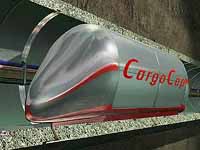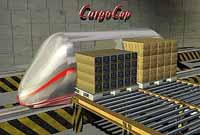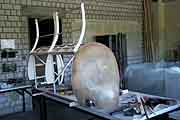Warning: The text reproduced here is a copy of information published elsewhere. This information has either:
- been published freely on the internet and has been cached here as a precaution against future loss of servers and links, or
- been published historically and very few copies of the original text are still available for research purposes.
It is recommended that you look at the original source given below first, and use this text only if that source is not available to you. It is not intended that any text cached here infringe the copyright of the original author. If any copyright owner wishes their text removed from this site, this can be done by contacting the author.
Document summary:
- Title: CargoCap
- Author: Britta Schößer/Dietrich Stein
- Source: http://www.cargocap.com/
- Copyright: CargoCap/Ruhr-University of Bochum
- Date: Cached August 2001
CargoCap
Short Description
In Germany the transportation of goods is mainly carried out on the streets. The traffic way street however comes up against limiting factors by steadily increasing demands on the transportation purpose resulting from the principles of most modern logistic conceptions. Daily reports on traffic congestions show that the traffic infrastructure is characterised by obstructions and delays and can thus no longer be efficient. This increasingly negative development of traffic becomes especially obvious in densely populated economic areas of Germany with an already high proportion of traffic expanses.
At present a flexible, fast and reliable distribution of piece goods into congested areas with an already problematic traffic situation only seems to be possible by a traffic system which executes transportations with the help of a means of traffic which is independent from the existing overloaded traffic infrastructure but connected to it. This system has to absorb the existing and still increasing streams of goods reliably and to have itself implemented into the existing infrastructure economically, fast and trouble-free under short periods for planning and building as well as less possible legal restrictions.
The result of a feasibility study executed at the Ruhr-University Bochum and supported by the Ministry of Education, Further Education, Science and Research of North-Rhine Westphalia is the conception of new, efficient and ecologically beneficial transportation capacities. This draft deals with transportation of piece goods to be executed by individually controlled transportation units through underground pipelines laid into the public traffic area. As examinations have shown a comparably small nominal width of the pipelines of DN 1600 is sufficient to absorb about 80 % of the transported piece goods - packaging sizes corresponding to the dimensions of the euro-pallets of 1050 mm. The underground route defuses above-ground conflicts about land utilization and guarantees the transportation process to be independent from current traffic obstructions.
By combining proofed constructions methods of trenchless technology with capable components of mechanical engineering with innovative technology to realise high degrees of automation all requirements have been fulfilled to project a blanket covering underground distribution network for economic areas to come up to specific transportation tasks. The use of eco-friendly steering techniques ensures better consideration of environmental acceptability. This idea - the 5th alternative of transportation - pushes above all the quick and economic implementation to the fore which is among others enabled by the rapid development of machine technique (mechanical engineering) in the field of trenchless technology during the past years. In the main the improvement of goods and economic traffic not only leads to a short-term guarantee but also to a long-term promotion of the quality of location of economic centres.
Present Situation
The efficiency and the development potential of an economic area, a region or a national economy are - even in the age of telecommunication - considerably determined by the presence of efficient transportation systems with high performance traffic routes - road, rail, air and water. In the Federal Republic of Germany most of these transportation systems meanwhile achieved their limits causing serious frictions and costs by traffic bottlenecks and delays.
This conflict situation between necessary mobility on the one hand and local restrictions on the other hand presents itself particularly critically for the developments of the traffic. On the one hand the development of business enterprises to just-in-time and just-in-case production require a reliable and efficient productions logistics which is based on the use of widely branched, flexible and economical traffic systems being able to safely transport the necessary quantities of goods from one place to another in a certain time. At the same time the number of motor vehicles rises substantially faster than the size of the road system (figure 1).
Densely populated areas with a traditionally evolved traffic infrastructure, which can be adapted to the new demands only imperfectly due to surface shortage or competitions, financial weakness of the local government or lack of acceptance in the population, are particularly concerned by this development. Consequently the traffic dilemma remains and leads to a decreasing efficiency of the region with corresponding effects for other areas, e.g. a diminishing location attractiveness for the population and the industry.
The development-limiting frictions of a completely overloaded traffic infrastructure become particularly clear in the densely populated areas of Germany, e.g. the Ruhrgebiet (figure2). In view of the high density of buildings and the already today high proportion of above-ground traffic surfaced bottleneck problems are not only a question of missing money. Rather planning related and technical bottlenecks as well as increased environmental request intensify the financially caused development and extension deficits. These infrastructural deficits there put on the brakes for the necessary structural change.
At present all efforts of the poloxy are directed towards overcoming of the financial bottleneck situation with the development or the maintenance of the existing route network. At the same time traffic planners concentrate on decreasing the driving time by reduction of traffic congestion and increasing the traffic speed. Some conceptions, e.g. the Telematik, are aligned to keep the traffic flowing smoothly in population centres by integrated traffic management systems and information centres and to thus master a high traffic volume.
The are surely correct steps, which will however not alone be sufficient to particularly cope with bottlenecks specific for population centres. Rather innovatory measures are necessary for this problem, meaning the development of easing new traffic systems. In other words: new solutions are demanded which permit as fast an easing of existing traffic routs as possible, which are of environmental exculpatory nature and which at the same time offer a lasting improvement of the traffic conditions, in particular with the goods traffic. This requires solutions of an enduring development fulfilling the needs of the presence without restricting the possibilities of future generations being forced to steadily develop new ways of transportation.
Application-orientated solution conceptions
At present a flexible, fast and reliable distribution of bulks in population centres only appears to be realisable by a traffic system which executes transportation of traffic routes independent of the existing, overloaded traffic infrastructure. One the one hand this system has to take up reliably the existing goods stream and on the other hand has to be able to be implemented fast and problem-free to the existing infrastructure by unreservedly short preparation, planning and construction periods as well as smallest planning related restrictions and resistances.

This is the starting-point for the innovative idea to execute bulk transportation by means of individually controlled transportation units in underground pipelines within the public street network. Above all the underground route system moderated the land utilisation conflicts and ensures the independence of the transportation process from above-ground traffic bottlenecks. Under application of innovative technologies for the implementation of high degrees of automation as well as precise control and monitoring units an extensive underground network can be developed. This is to take advantage of pollution-free propulsion technologies to accomplish specific transportation tasks and thus contribute to the better consideration of environmental interests.
In this connection interdisciplinary research has been executed at the Ruhr-University Bochum since 1998, which at present primarily concentrates on North-Rhine Westphalia (NRW). Being the most densely populated Land of the Federal Republic of Germany with the highest total population on a big expanse North-Rhine Westphalia is particularly suitable for these investigations. By the modifications in European environmental planning NRW as central turnstile in road and rail traffic more and more turns into a country of transit in east-west direction. The consequence of this increase in transit traffic is the strain on the regional streets in NRW which thus are less available for regional and local transportation.
The faculties of law, economy, mechanical engineering and civil engineering worked out a comprehensive feasibility study about execution of piece goods transportation by means of individually controlled transportation units through underground pipelines laid into the public street network in intensive interdisciplinary co-operation within a period of 18 months. As the investigations revealed already the relatively small nominal width of pipelines of DN 1600 will be sufficient to take up about 80 % of the piece goods to be transported packed correspondingly to the dimensions of the 1050 mm high Euro-pallet.

By the combination of proven construction techniques of the trenchless technology and high performance components of mechanical engineering with innovative technology for the implementation of high degrees of automation all prerequisites are created to project an extensive underground distribution network e.g. to accomplish specific transportation functions for the marketing area Ruhrgebiet. The application of pollution-free propulsion technologies ensures better consideration of environmental interests.
This idea puts above all a fast and economic implementation to the fore which is among others enables by the rapid development in mechanical engineering within the area of trenchless technology in the last years. The present status of the legal situation as well shows that the project can be realised briskly under predominant use of the public street network and will not be impaired by lengthy negotiations with property owners. Thus the improvement of the goods and trade traffic is not only covered at short notice but also promoted on a long-term basis.
The transportation process itself is to be effected in driverless and computer-controlled transportation units in which a modern electrical drive with appropriate regulation possibilities is applied. Here the track guiding devices are implemented directly in the pipe. In order to enable a sufficient exploitation and thus an optimum utilisation of the underground transportation pipe it is necessary to develop an efficient and rounded logistics concept which will be tested in the test track. The total conception of the transportation through pipelines requires development of precise steering and control engineering an equipment with efficient sensor technology. To be imbedded into existing material flow chains the planned transportation system requires flexible connections compatible with existing systems. This is to be achieved by the use of standardised transportation containers which are already proven in practice as the Euro-pallet.
The transportation units are to be designed as a fully automated concept as regards the mentioned modern drive and control conception as well as loading and unloading processes with the possibility of being implemented into existing logistic chains. In order to be able to guarantee the supply by underground pipelines at any time reliable safety facilities are be created. These not only concern the logistic concept itself but also the constructional production/making/execution of the transportation capsules and branch mechanisms as well as a control concept reacting effectively to operational disturbances.
By supporting the traffic infrastructure as suggested here a technology is promoted which is able to solve acute problems and those rising clearly in the future as well as similar problems in other regions of Germany, Europe and the world.
Model Device
At present a model device CargoCap in the scale 1:2 is being planned at the Ruhr-University. With this model the project partners from the field of Mechanical Engineering will test the main components of the transportation capsules with the aim to mobilize possibilities for optimisation of the capsule construction.

This model is to simulate a continuous operation within a closed ring system. In order to test the newly developed branch devices a parallel track section is planned. The complete device will be built on the grounds of the Ruhr-University above-ground on a suitable stand-construction which is easy to be assembled and dismantled.
A part of this model device will be presented for the first time on the denk 2001 on 19th and 20th May 2001 in the Ruhrlandhalle, Bochum, under the category "mensch: mobilität" (people: mobility) as project 09. Please find detailed information regarding this event under www.denk2001.de.
Contact
The interdisciplinary research and development activities have become possible by friendly support of the Ministry of Scholl, Science and Research of North Rhine-Westphalia.
Party to the co-operative research project are:
Prof. Dr.-Ing. Dietrich Stein (project leader)
Working Group of Pipeline Construction and Maintenance
Ruhr-University Bochum, Faculty of Civil Engineering
Contact address:
Universitätsstr. 150, 44780 Bochum,
Tel.: 0234/32-27445, Fax: 0234/32-14232,
Email: dietrich.stein@ruhr-uni-bochum.de
Prof. Dr. Paul Klemmer
Ruhr-Research Institute for Innovatin and Structure Politics (RUFIS)
Bochum
Prof. Dr.-Ing. Gerhard Wagner
Chair of Machine Parts and Material Handling,
Ruhr-University Bochum, Faculty of Mechanical Engineering
Prof. Dr. Thomas von Danwitz
Institute for Mining and Energy Law,
Ruhr-University Bochum, Faculty of Law
Prof. Dr.-Ing. Andreas Steimel
Chair for Generation and Application of Electric Energy,
Ruhr-University Bochum, Faculty of Electrical Engineering
Prof. Dr.-Ing. Stein & Partner GmbH
Consulting Engineers for Construction and
Maintenance of Pipelines and Environmental Techniques,
Ruhr Center of Technology,
Bochum
Hörtig Rohrpost, Dipl.-Ing. Martin Hörtig, Bayreuth
B. I. T., Consultant for Intelligent Information Technology, Prof. Dr.-Ing. habil. Wolfgang Weller, Berlin